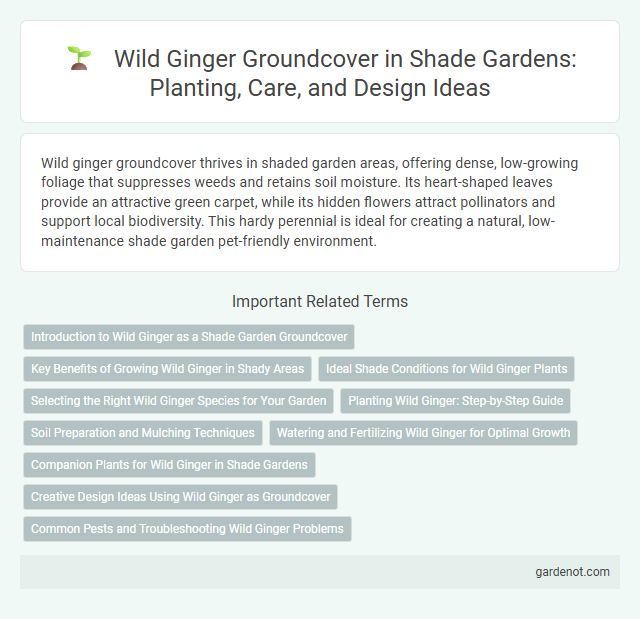Wild ginger groundcover thrives in shaded garden areas, offering dense, low-growing foliage that suppresses weeds and retains soil moisture. Its heart-shaped leaves provide an attractive green carpet, while its hidden flowers attract pollinators and support local biodiversity. This hardy perennial is ideal for creating a natural, low-maintenance shade garden pet-friendly environment.
Introduction to Wild Ginger as a Shade Garden Groundcover
Wild ginger (Asarum canadense) thrives as a dense, low-growing groundcover ideal for shade gardens, forming a lush carpet under trees and shrubs. Its heart-shaped, glossy leaves provide year-round visual interest while suppressing weeds and retaining soil moisture. This native plant adapts well to moist, well-drained soils, making it a sustainable and attractive choice for shaded landscape areas.
Key Benefits of Growing Wild Ginger in Shady Areas
Wild ginger groundcover thrives in shady areas, providing effective soil erosion control and natural weed suppression with its dense foliage. Its evergreen leaves maintain garden aesthetics year-round while supporting local wildlife such as pollinators and ground-nesting insects. The plant's low maintenance requirements and ability to improve soil moisture retention make it an ideal choice for sustainable shade gardens.
Ideal Shade Conditions for Wild Ginger Plants
Wild ginger groundcover thrives in deep to partial shade, making it ideal for dense woodland gardens or areas beneath deciduous trees where sunlight is filtered. The plant prefers consistently moist, well-draining soil rich in organic matter to support healthy growth under shaded conditions. Optimal temperatures range from 55degF to 75degF, with protection from harsh afternoon sun to prevent leaf scorch.
Selecting the Right Wild Ginger Species for Your Garden
Selecting the right wild ginger species for your shade garden depends on factors such as climate zone, soil type, and moisture levels. Asarum canadense thrives in moist, well-drained soils in USDA zones 3-8, while Asarum europaeum prefers slightly drier, shaded areas in zones 4-7. Considering growth habits and leaf aesthetics helps ensure a harmonious groundcover that complements your garden's microenvironment.
Planting Wild Ginger: Step-by-Step Guide
Wild ginger groundcover thrives in moist, well-drained, and shaded environments ideal for shade garden settings. Begin planting by preparing the soil, enriching it with organic matter, and spacing rhizomes 12 to 18 inches apart to allow for growth. Water consistently after planting to establish roots and mulch lightly to preserve moisture and suppress weeds.
Soil Preparation and Mulching Techniques
Wild ginger groundcover thrives in rich, well-drained soil with a high organic matter content, making soil preparation essential for optimal growth. Incorporating leaf mold, compost, or aged manure enhances moisture retention and nutrient availability in shaded garden beds. Applying a 2-3 inch layer of mulch, such as shredded bark or hardwood leaves, helps maintain consistent soil moisture, suppresses weeds, and protects roots from temperature fluctuations.
Watering and Fertilizing Wild Ginger for Optimal Growth
Wild ginger groundcover thrives in consistently moist, well-drained soil, requiring regular watering especially during dry spells to maintain optimal growth. Applying a balanced, slow-release fertilizer in early spring promotes healthy foliage and robust root development. Mulching around the plants helps retain soil moisture and reduces the frequency of watering.
Companion Plants for Wild Ginger in Shade Gardens
Wild ginger (Asarum canadense) thrives alongside hostas and ferns in shade gardens, creating a lush and textured groundcover. Combining wild ginger with astilbes and shade-tolerant heucheras enhances visual diversity and supports moisture retention in shaded soil. These companion plants complement wild ginger's low-growing habit, contributing to an attractive, resilient understory.
Creative Design Ideas Using Wild Ginger as Groundcover
Wild ginger groundcover thrives in low-light areas, making it ideal for shade gardens where it forms dense, lush mats that suppress weeds and retain soil moisture. Integrating wild ginger with ferns and hostas creates layered textures and a natural woodland aesthetic, enhancing biodiversity and providing habitat for pollinators. Its heart-shaped leaves and subtle flowers add year-round visual interest, perfect for pathways, borders, or under trees in creative landscape designs.
Common Pests and Troubleshooting Wild Ginger Problems
Wild ginger groundcover is generally resistant to pests but may occasionally suffer from slugs and aphids, which can cause leaf damage and stunted growth. Effective troubleshooting includes using organic slug baits and insecticidal soaps to manage infestations without harming the plant or surrounding ecosystem. Regular monitoring and maintaining proper moisture levels help prevent common issues such as fungal infections and root rot in wild ginger groundcover.
Wild ginger groundcover Infographic

 gardenot.com
gardenot.com